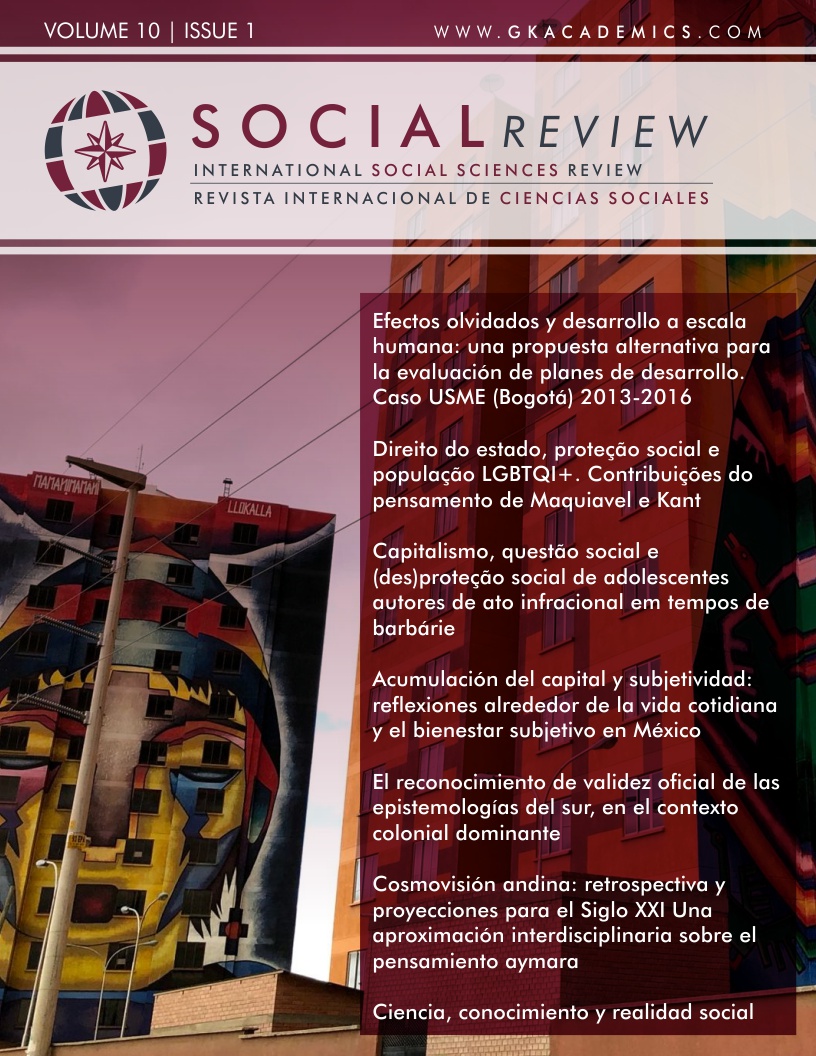Capitalism, Social Issue and Social Deprotection of Adolescent officers in Barbarian Times
DOI:
https://doi.org/10.37467/gka-revsocial.v10.2509Keywords:
Adolescence, Criminality, Social issues, Social deprotectionAbstract
The debate surrounding the adolescent who commits infringements is permeated by various conceptions and ideologies, which are grounded in a class society governed by capital. The classist, exclusionary and selective character is rooted in the Brazilian juvenile penal system and makes explicit the attempt to maintain the logic of marginalization, criminalization of poverty and blatant naturalization of the social issue. This scenario brings against the background the perversity of the violation of the fundamental rights of this population to the detriment of the expansion of public policies that are really capable of sustaining a model of integral social protection.
Downloads
Global Statistics ℹ️
|
388
Views
|
182
Downloads
|
|
570
Total
|
|
References
Baumam, Z. (2001). A sociedade individualizada: vidas contadas e histórias vividas. Rio de Janeiro: Zahar.
Brasil, Ministério dos Direitos Humanos (MDH). (2018). Levantamento Anual Sinase 2015. Brasília: Ministério dos Direitos Humanos.
BrasiL, Lei nº 8.069 de 13 de julho de 1990. Dispõe sobre o Estatuto da Criança e do Adolescente. 1990. Diario Oficial da União, Poder Legislativo, Brasília, DF, 13 jul. 1990. Disponivel em: http://www.planalto.gov.br/ccivil_03/leis/18069.htm>. Acesso em: 14 de julho de 2019.
Brasil, Lei nº 12.594 de 18 de janeiro de 2012. Dispõe sobre o Sistema Nacional de Atendimento Socioeducativo (SINASE). 2012. Diario Oficial da União, Poder Legislativo, Brasília, DF, 12 jan. 2012. Disponivel em: http://www.planalto.gov.br/ccivil_03/_Ato2011-2014/2012/Lei/L12594.htm. >. Acesso em: 14 de julho de 2019.
Comisión Económica para América Latina y el Caribe (CEPAL). (2018). Panorama Social de América Latina, 2017 (LC/PUB.2018/1-P), Santiago.
Fernandes, F. (2005). A revolução burguesa no Brasil: ensaio de interpretação sociológica. São Paulo: Globo.
Fundo das Nações Unidas. (2018). Bem estar e privações múltiplas na infância e adolescência no Brasil. Brasil: UNIFEC.
Imamoto, M. V. (2001). O serviço social na contemporaneidade: trabalho e formação profissional. São Paulo: Cortez.
Imamoto, M. V. (2011). Serviço social em tempo de capital fetiche: capital financeiro, trabalho e questão social. São Paulo: Cortez.
Iamamoto, M. V.; Carvalho, R. de. (2005). Relações sociais e serviço social no Brasil: esboço de uma interpretação histórico-metodológica. São Paulo: Cortez.
Instituto Sou da Paz (2018). Aí eu voltei para o corre: Estudo da reincidência infracional do adolescente no Estado de São Paulo. São Paulo: Instituto Sou da Paz.
Leal, D. M.; Macedo, J. P. (2017). A penalização da miséria no Brasil: os adolescentes “em conflito com a lei”. Textos & Contextos, 16(1), pp. 128-141, jan./jul. <https://doi.org/10.15448/1677-9509.2017.1.24550>.
Marini, R. M. (2000). Dialética da dependência. São Paulo: Editora Vozes.
Marx, K. (2010). Glosas críticas marginais ao artigo “O rei da Prússia e a reforma social”. Por um prussiano. São Paulo: Expressão Popular.
Marx, K. (2013).O capital. Livro 1. Critica a economia política. São Paulo: Boitempo.
Paniago, M. C. S. (2014). Crise estrutural e a centralidade das classes sociais. R. Katál., 17(1), p. 41-49, jan./jun.
Paulo Netto, J. (2007). Desigualdade, pobreza e Serviço Social. Em Pauta, 19, pp. 134-170.
Scherer, G. (2013). Serviço social e arte: juventudes e direitos humanos em cena. São Paulo: Cortez.
Scisleski, A. C. C. et al. (2015). Medida socioeducativa de internação: estratégia punitiva ou protetiva? Psicologia e Sociedade, pp. 505-515.
Tejadas, S. S. (2005). Juventude e ato infracional: as múltiplas determinações da reincidência. 2005. Dissertação (Mestrado em Serviço Social) - Pontifícia Universidade Católica do Rio Grande do Sul, Porto Alegre.
Zaffaroni, E. R. (2012). A palavra dos mortos: conferências de criminologia cautelar. São Paulo: Saraiva.
Wacquant, L. (2001). As prisões da miséria (trad. André Telles). Rio de Janeiro: Jorge Zahar.
Downloads
Published
How to Cite
Issue
Section
License
Those authors who publish in this journal accept the following terms:
-
Authors retain copyright.
-
Authors transfer to the journal the right of first publication. The journal also owns the publishing rights.
-
All published contents are governed by an Attribution-NoDerivatives 4.0 International License.
Access the informative version and legal text of the license. By virtue of this, third parties are allowed to use what is published as long as they mention the authorship of the work and the first publication in this journal. If you transform the material, you may not distribute the modified work. -
Authors may make other independent and additional contractual arrangements for non-exclusive distribution of the version of the article published in this journal (e.g., inclusion in an institutional repository or publication in a book) as long as they clearly indicate that the work was first published in this journal.
- Authors are allowed and recommended to publish their work on the Internet (for example on institutional and personal websites), following the publication of, and referencing the journal, as this could lead to constructive exchanges and a more extensive and quick circulation of published works (see The Effect of Open Access).













